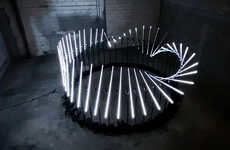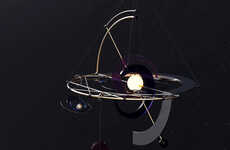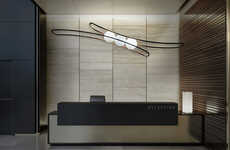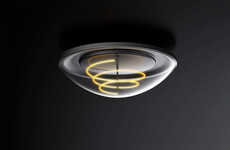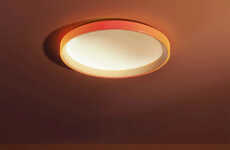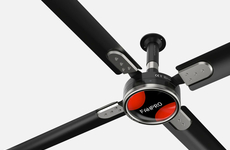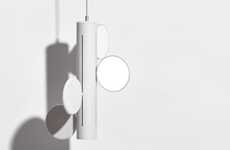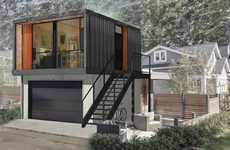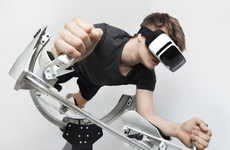
This Ceiling Installation Responds to Movements Of People
Rahul Kalvapalle — March 30, 2016 — Art & Design
References: behnazfarahi & gizmag
Aurora is a fascinating new permanent ceiling installation, located at the University of Southern California, that is designed to be capable to move and react in response to the movements of people walking beneath it.
The ceiling is equipped with five disks that are covered in industrial felt, and four stationary desks. The ceiling is activated by an Xbox Kinect camera that detects movement and translates it in such a way that the ceiling is actuated through its panels. The discs respond to this movement by moving up and down and rotating in different directions, and the ceiling is also equipped with lighting that switches on or off based on the path of the room's visitor.
This interactive ceiling installation is a great example of reactive architecture that could be of great use in every setting from military to marketing.
The ceiling is equipped with five disks that are covered in industrial felt, and four stationary desks. The ceiling is activated by an Xbox Kinect camera that detects movement and translates it in such a way that the ceiling is actuated through its panels. The discs respond to this movement by moving up and down and rotating in different directions, and the ceiling is also equipped with lighting that switches on or off based on the path of the room's visitor.
This interactive ceiling installation is a great example of reactive architecture that could be of great use in every setting from military to marketing.
Trend Themes
1. Reactive Architecture - The motion-activated ceiling installation demonstrates the trend of reactive architecture, which has disruptive innovation opportunities in various industries.
2. Interactive Environments - The ceiling's ability to respond to movements creates a trend of interactive environments, presenting disruptive innovation opportunities in sectors such as entertainment and retail.
3. Sensor-based Technology - The use of the Xbox Kinect camera to detect movement showcases the trend of sensor-based technology, opening doors for disruptive innovation in fields like healthcare and automation.
Industry Implications
1. Military - The concept of reactive architecture can be applied in military settings to create adaptable and responsive structures, leading to disruptive innovation in military infrastructure.
2. Marketing - Reactive architecture can revolutionize marketing experiences by creating interactive environments, providing disruptive innovation opportunities in immersive brand activations and experiential marketing campaigns.
3. Entertainment - The ability of the motion-activated ceiling to engage and entertain visitors highlights the potential for disruptive innovation in the entertainment industry, such as interactive installations in theme parks or interactive displays in museums.
3.6
Score
Popularity
Activity
Freshness



